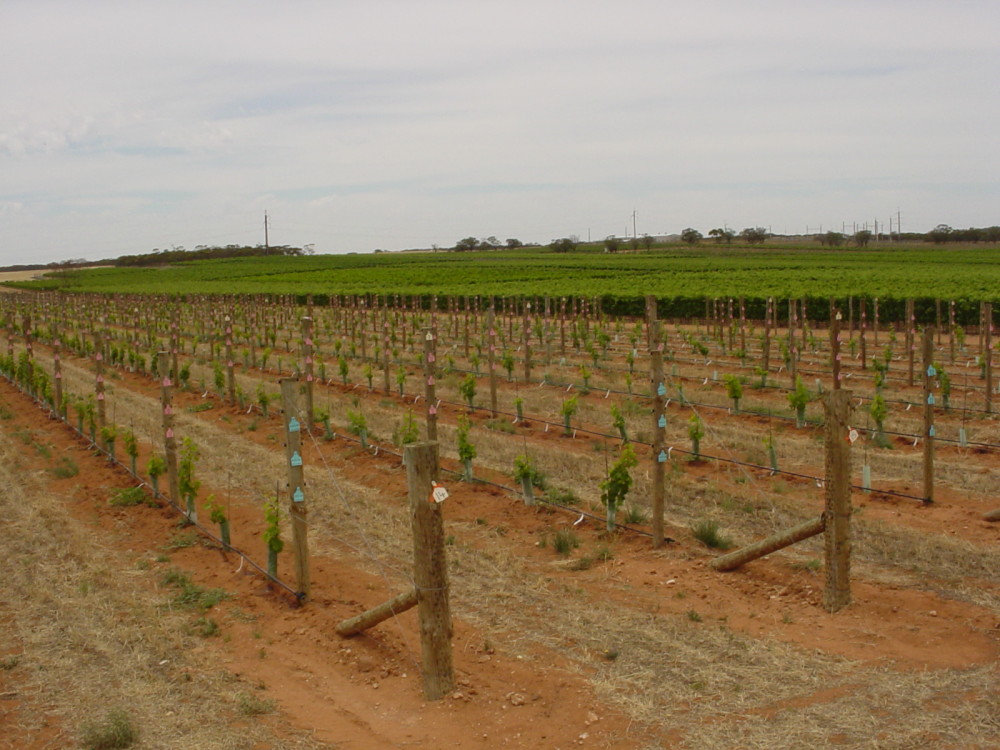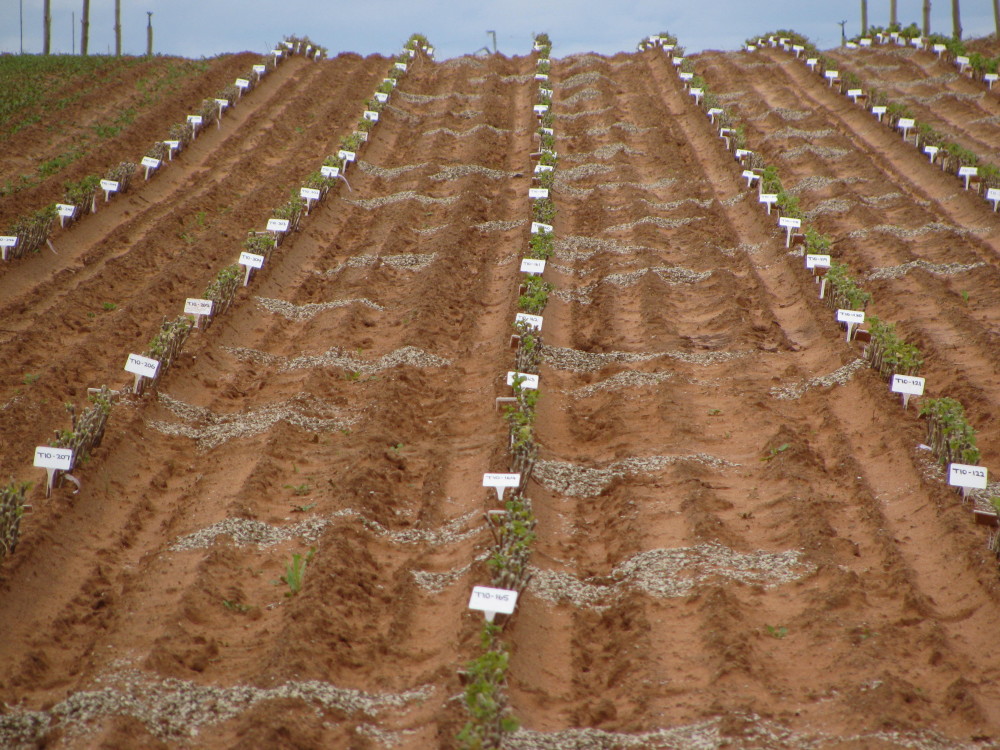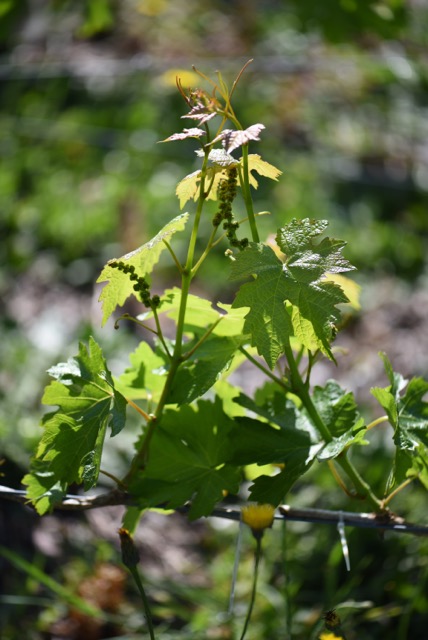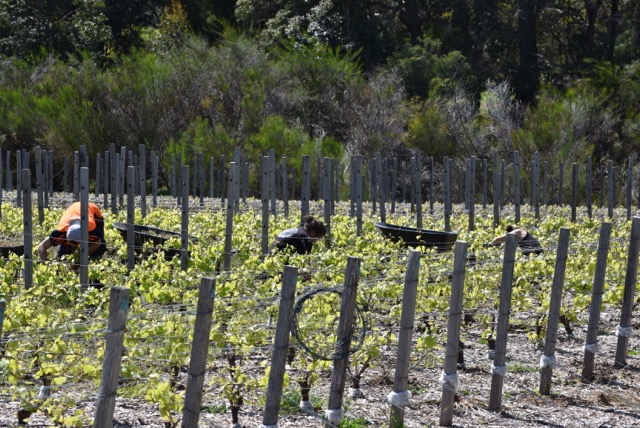Riverland Clonal Project
Barry Weinman: 1st November 2015
The Riverland Clonal Project has set out to identify the grapevine clones that are most suitable for the Riverland. The project is trying to identify vines that produce high quality wines efficiently. Factors include:
- Water efficiency
- Crop size and consistency
- Grape/wine quality
- Commercial viability

Photo courtesy of the RVTG
Background
The Riverland Clonal Project is run by the Riverland Viticultural Technical Group (RVTG), a sub-committee of Riverland Wine. The RVTG includes growers, winery representatives and technical members who collaborate on a variety of projects aimed at benefiting the region.
The Program is funded by Wine Australia as part of the Regional Extension Program.
The initial vines were planted 5 years ago, primarily covering Chardonnay, Merlot, Shiraz and Cabernet Sauvignon. In total 96 clones were planted, all on the same rootstock. The project has since expanded to include other varieties that may be particularly suited to the warm, dry conditions of the Riverland.
At first glance, Chardonnay might seem like an interesting choice for what is a very warm region. It is worth highlighting that the Riverland produces 40% of Australia’s Chardonnay.
Interestingly, the Riverland is also the biggest producer of organic wine in Australia, which is providing a much-needed boost in profitability for some growers, given that the returns can be as much as 4 times that of grapes grown non-organically.
Water
Water conservation is a priority for the region. The cost of irrigation strips any profitability out of production for many growers. According to the RVTG:
Water use differences are more influenced by the root-stocks rather than the clones. Most of the recent redevelopment has been on water efficient root-stocks such as Ramsey and Ruggeri 140. When these vines are well managed, the vigour is controlled and high quality wines can be produced with little water.
Almost all vineyards in the Riverland are now irrigated with drip irrigation, and use soil moisture monitoring to ensure that the water use efficiency is as high as it can possibly get.

Photo courtesy of the RVTG
Results
Three years ago, the project started to produce wines from the various clones to look at the results. The wines were all made at a contract winery in Victoria (DPI) in 50kg parcels. For each grape variety, all fruit was treated in the same way. With Chardonnay for example, the grapes were picked at 13.5% Baume, fermented in stainless steel and saw no oak.
Going forward, the winemaking will be brought in-house, to be made by Melanie Kargas, winemaker for the RVTG. Picking times will be refined to bring down the level of alcohol and focus on purity of fruit. This would make the test wines more representative of where the market is going.
At this early stage, what is clear is that the different clones produce very different profile wines. This will help winemakers to select clones that best complement the style of wine that they are striving to produce.
The one variety that really stands out is Merlot, with broad recognition that some of the test clones are superior to those that are used commercially in the region.
Chardonnay
Vintage 2015
The wines tried showed a remarkable diversity in style, from restrained and austere, to rich and expansive. Clearly the Riverland is capable of producing quality Chardonnay with careful clonal selection.
Clone 96: Floral notes, but with a core of minerality. The palate is rich and expansive, showing lemon, melon and grapefruit acidity, with a creamy finish.
Clone 95. Muted, tight fruit on the nose. The palate is all pineapple and citrus, but the finish is quite muted.
Clone 76 AR. Creamy, peach-like fruit on the nose. Big, bold flavours in the stone fruit spectrum, with lovely lemony acidity.
ENTAV 809 AR. Pretty, floral fruit that justifies the “Muscat” tag. Continues on the palate with a mouth-feel and acid that is not dissimilar to Sauvignon Blanc. Bright acidity.
Clone 548. A very balanced profile, with floral fruit leading to grapefruit and melon. Sits very much in the middle ground.
ENTAV 1066. Peach, citrus, nectarine, grapefruit, melon. There is a lot going on here and the drive on the finish is noteworthy.
Merlot
All grapes were picked at 13.8 Baume, received minimal skin contact and no oak. Acid was adjusted to 3.3pH in all wines and no malolactic fermentation was allowed due to the small batch size.
A couple of the wines here came across as a little warm. Melanie will look to adjust the Baume and introduce malolactic fermentation in subsequent years, to get a better idea of how each clone is performing.
D3V14. Plump and plummy fruit on the nose, with herbal, menthol and red berry characters. Gritty tannins carry the fruit nicely. Trying this, it is easy to understand why Merlot is so popular with some consumers.
8R. Less floral and more subdued than D3V14. Some graphite and tar notes add interest. The palate is a little overcooked, but the structure is noteworthy. A more refined/balanced wine with cassis and leafy notes.
ENTAV 181. Pretty fruit. Perfumed, yet mineral like, with decent structure and mouth-feel. A very balanced wine that will stand-alone well.
Q45-14. Decent concentration and depth to the fruit on the nose. Pretty red fruits on the palate, yet with excellent structure. Savoury, though the herbal tannins are a little green.
ISV F6V4. Muted, lacks vibrancy or depth.
3 Italy. Pure, varietal fruit with clarity and vibrancy. Red currant and blueberry fruit, with fine tannins. A pretty wine that suffers from being a little over-ripe.
Non-Mainstream Varieties.
Yalumba – Vermentino – 2014. Vibrant aromas with a savoury edge. Precise fruit that, whilst not overly concentrated, is pretty and satisfying. The pithy, drying finish adds to the charm. Very refreshing.
Unico Zelo – Fiano – 2015. Lovely Muscat-like fruit, with sherbet and delicate spice. The palate is vibrant and textured. Perfumed fruit continues on the palate, with musk-like notes and Turkish Delight. A delightful drink. (Basket pressed, wild ferment – at temperatures up to 40 degrees. Irrigation turned off at flowering, and no acid adjustment made).
Amato Vino – Bele – 2015. Really savoury with an almost saline lift to the nose. This is really interesting. Spice, with brine-like characters. This is a savoury, complex wine that will partner richer food dishes really well.
Whistling Kite – Montepulciano – 2014. Lovely cherry fruit, with savoury tar and spice. The palate is really structured and the tannins prodigious, but very fine. Will be a treat with a steak now, but a few years will see this open up nicely.
Cirami – Lagrein – 2014. Almost Shiraz-like, with dark plum-like fruit on both the nose and palate. This is a dense, powerful wine that will appeal to those who like a big red. Bring on a decent steak.















